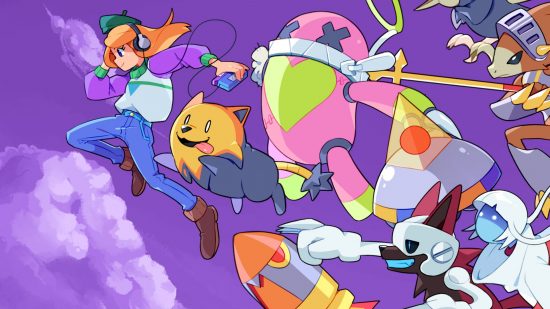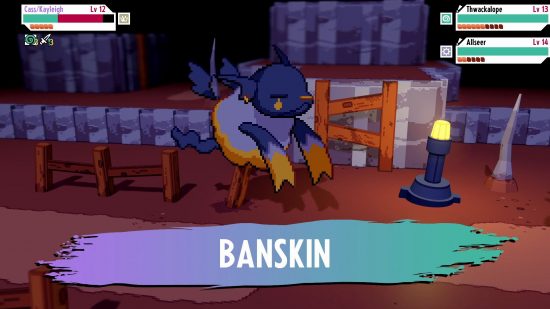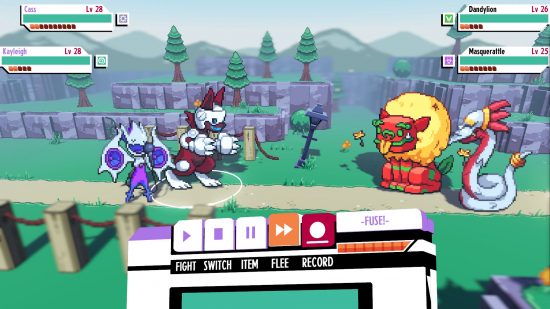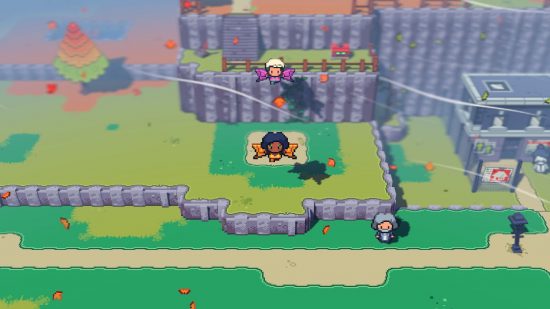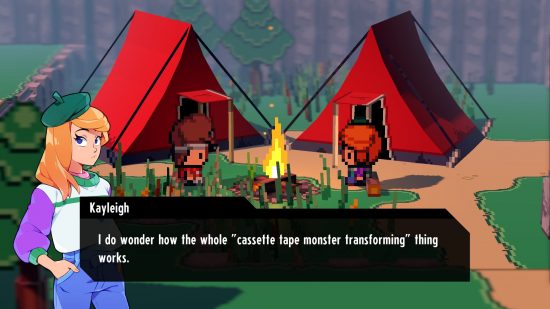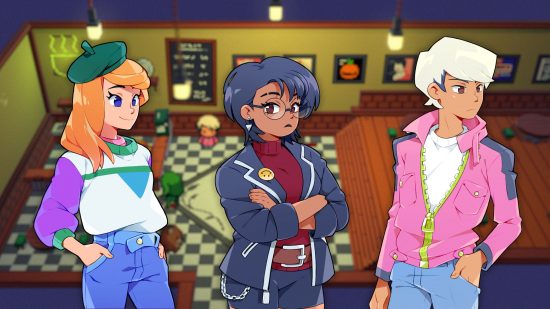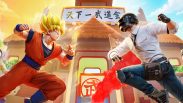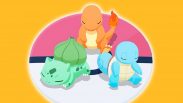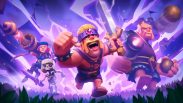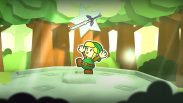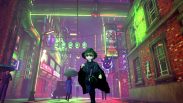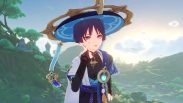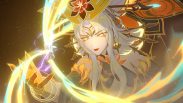Monster-catching isn’t really my thing. Sure, I like my dogs and everything, I still own a Tamagotchi too, but I’ve never been a Pokémon obsessive. I think I’m the only one on the PT team who doesn’t love it.
So, when a game with that sort of mechanic does turn my head, it feels special. Shin Megami Tensei? Heck yeah. Dragon Quest V? I sure should play it instead of just watching other people play it. Cassette Beasts? Well, that’s something new.
Cassette Beasts is an upcoming indie game from Bytten Studio, aka Tom Coxon and Jay Baylis, and it turned my head for two reasons. Firstly, it looks hot, and I want to play it. Secondly, it’s made by a tiny team, which always sounds interesting. How does that work? Do two people go stir-crazy? Or does it just smooth out all the communication issues?
“In many ways, it’s helped us get stuff done fast – because there’s been so much to do, we tend to make decisions fast and commit to them rather than experiment with multiple choices for every aspect of the game”, Jay told me. “It has meant that there’s been a lot of work, of course!”

Also, it’s not right to say that Cassette Beasts is the work of two people: “whilst Bytten Studio is a two-person team, it’s not entirely accurate for us to pretend it’s been a two-person project. Our animator Michael, our character illustrator Sami, and my brother Joel on music all helped shaped the final game – not to mention the invaluable support and assistance from Raw Fury and various other teams.”
Either way, even with this assistance, Cassette Beasts still feels and looks a little too massive for such a small group. It has lovely 2D character and monster art in a 3D world that hits right away, but when you dig deeper the hits keep hitting.
There are 120 different monsters to catch in Cassette Beasts, which the residents of Harbourtown can record to a cassette tape. When they play it back, they take on its battle form to do some fighting. What makes things more complicated, however, is that you can combine any two forms together – that means there are 14,400 combinations.
So, step one: design and animate 120 different monsters. Step two: get them all to mesh together with some wizardry I’m sure I couldn’t think up. Was there a clever process for the first step, or was it a matter of plain old hard work?
“It was, ultimately, just a lot of hard work! Designing a bunch of monsters like this is something I’ve been eager to do my whole life so it was a real treat, albeit a challenging one, to get to do it.
“Our animator Michael did a fantastic job bringing all my sprites to life. For the monsters, we wanted them to look like a true ‘set’ together – one of the ways I did this was by sharing the same pool of around 20 colours across all 120 monsters.” Like a toybox, then, of different ideas, but with a set number of crayons? Jay has a different analogy.
“I like to imagine it like an action figure set that was limited in the amount of plastic colours they had to work with. Other than that, the monsters pull inspiration from animals, mythology, folklore, all sorts. The only rule was that a monster should always look more powerful than a human would be, since the game involves transforming into monsters so that you’re strong enough to battle.”

So, keeping things streamlined clearly helps, but how do you take the hard work of 120 unique monsters and work out the fusion system? I’m genuinely intrigued about the trickery put in to make everything work.
“We had a few versions of this system before settling on one that essentially mix-and-matches ‘parts’ – monsters each have a second animated version that is modular, and the fusion engine mixes those modular parts together. The stats of both monsters are combined too, and you can end up with very broken fusions. However… we’re not too worried about that. We think people will have fun finding overpowered fusion combinations.”
It’s a wonderful idea – that you can make a set of monsters, then layer on a system which the player can just go wild with. And it’s not something completely new for Bytten Studio. The team’s previous game, Lenna’s Inception, could be (somewhat reductively) summed up as Zelda with procedural generation. It’s like, take something Nintendo, and twist it.
“Both Tom and I grew up primarily on Nintendo games so it is somewhat unsurprising that a lot of what we put into our own games is very Nintendo-inspired”, Jay says. “Nintendo games have a very timeless quality to them which I think is appealing to indie developers – as well as their games not needing huge budgets or state-of-the-art graphics to be fun.”
Still, Nintendo comparisons aren’t completely fair, either. To say Cassette Beasts is like Pokémon ignores a lot of the other stuff going on. Yet, it is an easy comparison to make. Has it been a challenge to showcase the game with all the Poké-comparisons?
“I think Cassette Beasts is and isn’t like Pokémon in a lot of ways, and we are fully aware that the comparison is always going to be one of the first ones players are likely to make. Pokémon is the most popular game franchise in the world, and we share a genre with it!
“There’s pros and cons to this – a lot of fans of Pokémon might find our game just by looking for games that are similar, but it also means we have to prove our game isn’t a ‘clone’. A lot of players come in expecting something 1:1 with Pokémon’s gameplay, tone and structure and then are surprised to see that, in practice, it’s kind of its own thing.”
One way Cassette Beasts sets itself apart is its art style – it’s not just a big pile of monsters here, but a pretty world for them to hang out in, too. How do they decide on an art direction, and how much does the gameplay influence it?
“I’m a pixel artist by trade – it’s what I learned when I was first making games as a kid and it’s the medium I’m most interested in. As the art director, I suppose our art direction is limited by me! We often say that we think it would be better for our games to be high-quality pixel art games vs average or poor-quality 3D games.
“However, as Cassette Beasts uses 2D character art in a 3D environment, we’ve been able to take advantage of the 3D world to add 3D traversal to the exploration. In terms of the broader art direction, we’ve leaned into what I like to call “GBA HD” – if you see something like Octopath Traveller as a 3D reimagining of SNES RPGs, then Cassette Beasts is much more tapped into RPGs you would have seen on the Game Boy Advance.”
Another thing occupying Jay’s focus is building out characters. It looks like Casette Beasts has more of a focus on characters – and we’re talking humans here – both in its writing and also mechanically. Was that the plan from the outset? Or did the gameplay demand more depth there?
“A focus on characters was always something I was interested in from the very outset of the project. I have a wider theory that games often undervalue the importance of character writing, and that character moments tend to be the ones in games that we remember the best.
“There was also an opportunity to put focus on aspects that other games in this genre don’t focus on so much – whereas in other ‘monster-collecting’ games the monsters are the focus, in Cassette Beasts the people are the monsters, in a sense. So making them and their personalities the focus came together very naturally.”
This side of things gets me quite excited. I played about 40 hours of Pokémon Sword & Shield and had a Just Fine time. But one thing I definitely didn’t like was the characters, talking to you like they’ve been through a lobotomy and can only utter phrases related to Pokémon and how to play the game correctly. It’s numb wallpaper.
But when you play many indie games that focus on writing, a personality comes through. No decided-by-committee or E-for-everyone carefulness – you can hear someone’s voice. You may not love that voice, you may not even agree with that voice. But you can hear a person. That’s something to look forward to in and of itself.
But, if that was enough, I’d read a book. Luckily, all the other aspects of Cassette Beasts seem to be coming from exactly the right place. Sure, you collect monsters and fight with them, but you can also combine them together, to an extent so massive that the Bytten team is more than ready for people to break it; in fact, they’re excited. And that means I’m excited.
Given all that, can Jay see what’s next for the team? “Our heads and hearts are still with Cassette Beasts for the moment! Whilst we have a lot of ideas for the future, they’re going to depend a lot on how Cassette Beasts is received.” You know what that sounds like to me? That sounds like you should probably buy Cassette Beasts, ‘cause it looks pretty cool.
Cassette Beasts is out on Nintendo Switch, Steam, and Xbox, sometime this year, but if you want more monster-catching in the meantime, check out our guide to the best games like Pokémon or our favourite monster games for some more monstrous mayhem.
